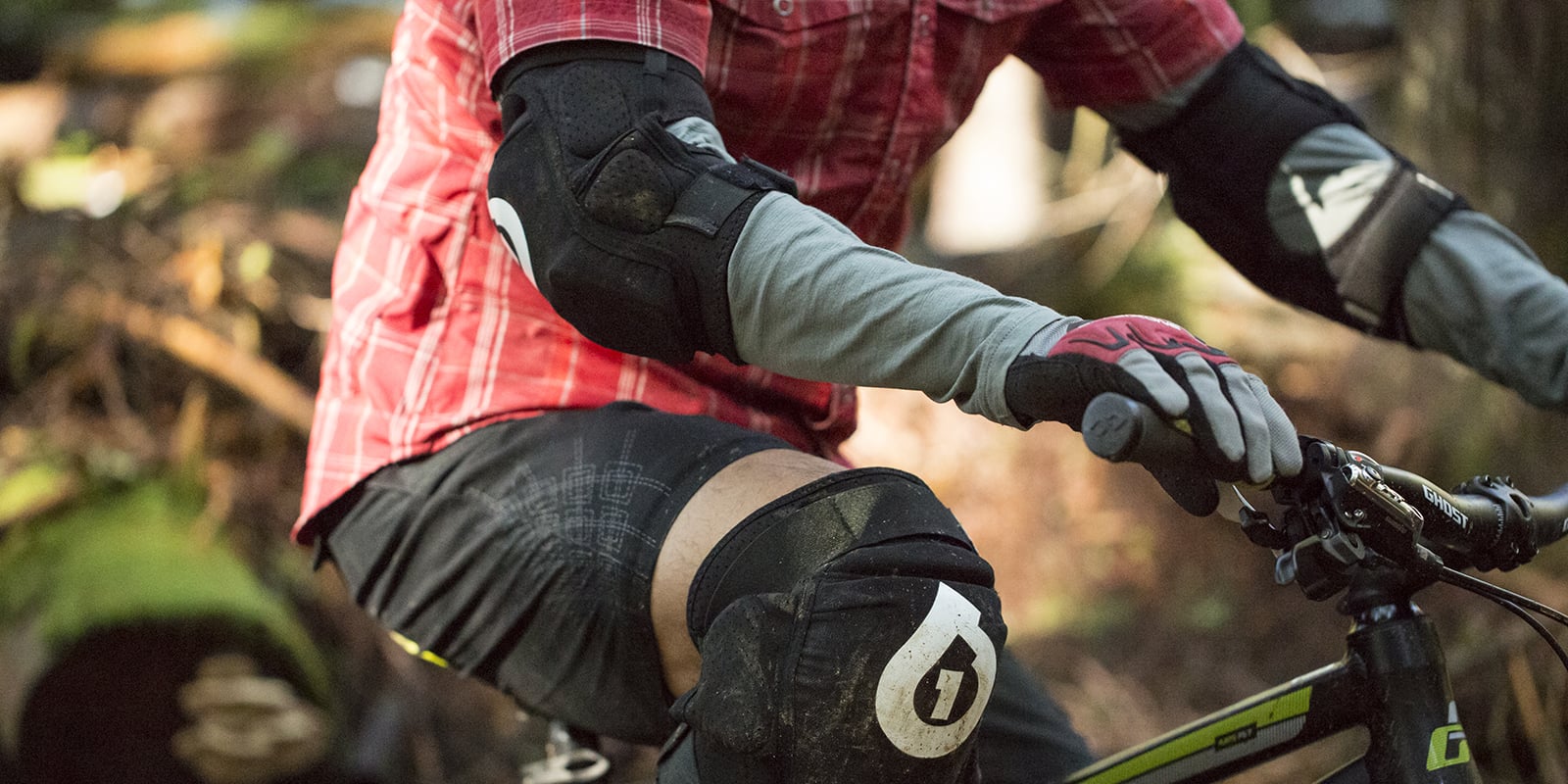A mountain bike looks very different from a road bike, so it only makes sense that the rider would, too.
There's no law against wearing clingy road shorts or baggy hiking shorts when you ride beyond the pavement. But you'll enjoy time on your mountain bike a lot more if you have clothing and protective gear that fits what, how and where you ride.
Protection is key, too. Whether your riding approach is cautious or audacious, you'll want ample coverage to protect you from the hazards of brush, branches, roots and rocks. If you're unsure how you'd classify your riding style, check out our article on mountain biking for beginners.
This article includes some things to consider as you decide what goes into your mountain-bike gear closet.
Mountain Biking Shorts and Padding
Like their road counterparts, mountain-bike shorts offer stretch for easy leg movement and a padded crotch liner to reduce friction and wick moisture. Padded liner shorts and shell shorts can also be purchased separately.
For most styles of mountain biking, aerodynamics is rarely a concern, so your shorts can have a baggy fit. However, if you race or ride a cross-country bike, you'll likely choose shorts that are tighter fitting and more aerodynamic. And some fitness riders prefer form-fitting shorts because they provide muscle support.
Most mountain biking shorts have sturdy fabrics and plenty of pockets. As your need for abrasion protection increases, so should the weight of the fabric and the length of the shorts. Downhill riding shorts, for example, should be thicker and longer than shorts worn for other riding styles.
Padding: Integrated padding in mountain bike shorts can be slightly thinner than in road shorts because you sit more upright and your riding position continually varies between seated and standing.
Most liners are removable, which gives you the option of buying bike underwear—separate, padded liner shorts. (Note that, regardless of the option you choose, don't wear non-bike underwear with your liners, because you'll likely suffer from chafing.) Whether you choose the integrated liner or separate bike underwear is largely a matter of personal preference.
Mountain Biking Jerseys
Generally, mountain-bike jerseys don't differ too much from road styles. In order to efficiently wick away sweat, they will be close-fitting, but perhaps a bit looser than road-bike jerseys. For more gravity-oriented riding styles, the fit can be even looser. Longer sleeves provide additional coverage from brush and branches.
If you plan to wear a pack, rear pockets won't be needed. For packless rides, pockets are handy for stashing keys, food, a tire-repair kit, a phone and cash.
A ventilating front zip is nice to have when you're pushing the pace or climbing hard, so many cross-country riders look for this feature.
Mountain Biking Gloves
Two features distinguish the gloves mountain-bike riders wear from the gloves of road cyclists: padding and finger coverage.
Because grips are padded on a mountain bike, having padding in gloves is optional. For rides lasting several hours or more, you may appreciate the increased comfort padding provides. Gloves with no padding, though, are lighter, cooler and allow you to maintain better bar feel—a plus when you're doing steep, fast or technical descents.
And you see far fewer fingerless gloves in the wilds. Sweaty hands are a minor discomfort compared to bloody knuckles, so full-fingered gloves are almost always the wiser way to go.
Cold-Weather Clothing for Mountain Biking
Cold-weather gear extends your riding season earlier into spring and later into fall. Rain/wind protection is a wise addition to your pack year round. Add insulating layers and you can be ready to roll any time the forecast mentions "cold front."
Tip: Before the start of a long climb, remove layers until you feel cool. If you start out feeling warm and comfortable, you're likely to feel overheated for most of the climb.
Bike Jackets
You find fewer mountain-bike-specific designs in outerwear. The primary difference from road outerwear is more durable fabrics. You do want a cycling-specific design, though, because it can offer better wind protection on front and will be tailored to provide comfort through the shoulders and coverage when you lean forward in the saddle. It should also have a helmet-compatible hood.
For serious protection, a waterproof/breathable jacket is a must. For short rides and moderately gloomy weather, some riders take a featherweight shell that packs small enough to fit in a jersey pocket.
Bike Tights and Pants
Bike tights, most of which are padded, can be substituted for your liner shorts on cold days. And similar to bike jackets, you'll want a pair of waterproof/breathable pants if you intend to ride when the weather gets damp.
Insulating layers
For your upper half, you can get the wicking and warmth you need from a long underwear top or a lightweight fleece jacket. Avoid cotton: Wool, polypropylene and nylon all perform well.
Arm/Leg Warmers and Hats
Arm warmers, leg warmers and a cap or headband are versatile layering options because they're easy to put on and take off as conditions change throughout your ride.
Mountain Biking Footwear
Pedal Compatibility: Your first consideration is compatibility with the type of pedal system you choose. You can also get shoes that work now with platform pedals and can accept a cleat later to work with a clipless pedal system.
Walkability: Another big consideration for mountain biking is how much walking you anticipate. Grippy rubber outsoles with lugs make walking on trails and scrambling over obstacles easier to do, which you will do more often if you're a newer rider. And if your bike becomes unrideable after a mishap, you might also be going on a hike.
Pedaling Efficiency: Stiff cross-country/trail shoes are designed for efficient pedaling, but can be more difficult to walk in. These shoes are also usually better vented than softer, street-shoe-styled options.
Waterproof Protection: For wet, cold conditions look at shoes with waterproof liners. Another option is to buy a pair of shoe covers.
For more details about shoes and pedals, see Bike Shoes: How to Choose.
Mountain Biking Helmets
Your style of mountain biking is the main consideration when you're picking a helmet. Disciplines that require more technical skill and have steeper descents simply require more coverage.
Cross-Country Riding: Speed on the uphill counts here and the downhills typically aren't all that steep. So look for a helmet with similar coverage to a road helmet and one that offers plenty of ventilation.
Trail Riding: Trail riders usually encounter more technical terrain than cross-country riders. So you can look for more protection and coverage—longer on the sides and back—than you'll find in a road or cross-country helmet.
All-Mountain/Enduro: This type of riding often includes steep, technical, and high-speed descents, so you need more coverage than trail riders do. A good feature to look for is a detachable chin bar: You can ride without it much of the time, but you'll want to snap it on when you're preparing for a big descent.
Downhill/park: This is a maximum coverage style of riding. That means a full-face helmet, and perhaps a pair of goggles rather than sunglasses.
To learn more about bike helmets, see our Bike Helmets: How to Choose article.
Mountain Biking Pads and Armor
The advice for pads follows that for helmets: You want more padding and more coverage as you get into more extreme styles of riding.
Trail and cross-country riders can go with more lightweight padding. More experienced riders might carry only knee pads, while newer riders might want to protect their elbows, too. In order to stay cooler, more experienced riders sometimes won't put on any of their padding until they're poised at the top of a long downhill stretch.
All-mountain/enduro riders need thicker, longer pads.
Downhill/park riders will also need them, often adding a pair of shin guards to complete their coverage.
Mountain Biking Packs
Unless you're racing or on a really short ride, you'll want a pack that can carry all of this great gear you got. That includes the Ten Essentials plus your bike-repair gear. Most riders prefer packs that come with a reservoir or are set up to carry one.

